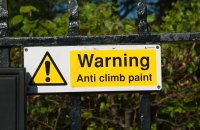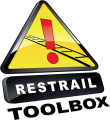
9.4 Measures to soil clothes
Concerns measures that prevent access to the railway by soiling the clothes of trespassers. Also known as "filthy fencing".
- Can be achieved through dirty physical barriers such as a greased fence, a muddy ditch, etc.
- Fences can be smeared with anti-climb paint (also known as anti-vandal grease, anti-intruder paint, or non-drying paint), reflective paint, or other oily film that sticks to the clothes or the skin of the trespasser.
- Where possible use this measure instead of simple fencing because:
- It may have a better dissuasive effect on trespassers due to its implicit message which is not the crossing interdiction (as in the case of simple fencing), but rather the crossing impossibility.
- The perceived cost of crossing (i.e. getting dirty) is likely to be unacceptable for most people.
- In case of emergency, make sure that the train passengers are not “fenced in” and instruct how to evacuate.
- The effect is stable assuming that control and maintenance is done. However, trespassers might change location over time and fencing could result in more dangerous routes for trespassers. Therefore, maintain the integrity of the fence, ditch etc. and repair defects without delay. At the same time keep monitoring a much wider perimeter in order to spot possible new trespassing locations.
- It cannot be implemented in all kinds of environments, for example it may be difficult to implement at or around main stations.
- May require special approvals.
- Such a measure would also require the building of under- or overpasses to enable safe access from one side of the track to the other.
- Compulsory combination with warning signs.
- The bars on each side of the gap were smeared with heavy grease (Lobb, Harre, & Suddendorf, 2001). Fencing reinforced with measures to soil clothes combined with signage influenced the rate of trespass which decreased substantially (from 59% to 40%), and the decrease was sustained and even greater three months later (from 40% to 36%).
last update: 2022-12-01 Print

